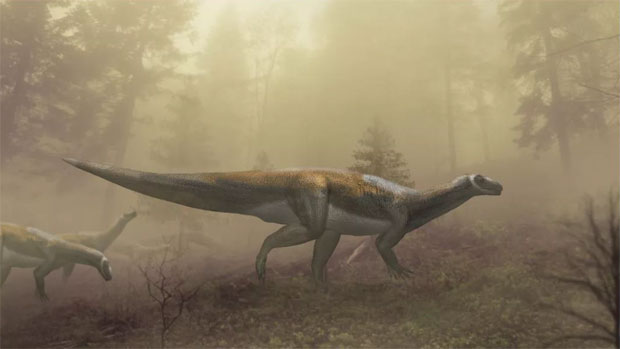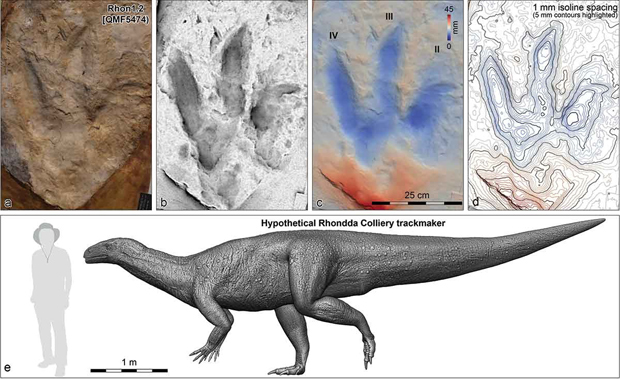Fossilised dinosaur footprints dating from the Late Triassic that were once thought to represent a large, predatory dinosaur have been re-examined and are now thought to have been made by a mainly vegetarian sauropodomorph. A series of fossilised footprints preserved on the ceiling of a gallery in a coal mine close to the suburb of Dinmore (Queensland, Australia), had been assigned to the ichnogenus Eubrontes. The three-toed tracks, discovered in 1964, were thought to represent a track made by a large theropod dinosaur. They were regarded as the earliest known evidence for the presence of big meat-eating dinosaurs, however, the tracks have been reassessed and are now thought to represent a basal sauropodomorph.

Walking on the Ceiling?
University of Queensland palaeontologist, Dr Anthony Romilio, lead author of the scientific paper published in the journal “Historical Biology”, commented:
“It must have been quite a sight for the first miners in the 1960s to see big bird-like footprints jutting down from the ceiling”.
Around 220 million years ago, dinosaurs walked across water-sodden layers of plant debris and these tracks were later filled in by fine silt and sand. Over millions of years the plant material turned into coal and this was removed by the miners, leaving a ceiling of siltstone and sandstone in the excavated galleries complete with the preserved natural casts of the dinosaur tracks.

The First and Only Evidence of an Australian Basal Sauropodomorph
The coalmine has been closed down, but the original photographs, drawings and plaster casts made in the 1960’s were available for study and under close scrutiny, the research team recognised that the tracks shared characteristics with the sauropodomorph ichnogenus Evazoum.
The Sauropodomorpha is a sister clade to the Theropoda within the lizard-hipped dinosaurs (Saurischia), the first sauropodomorphs evolved around 230 million years ago and these, large-bodied, long-necked herbivores were the ancestors of the huge sauropods that were to dominate many terrestrial ecosystems in the Jurassic. If the research team’s interpretation of the ceiling tracks is correct, these prints provide the first and only evidence of basal sauropodomorph dinosaurs from Australia.

The coalmine ceiling tracks suggest that the sauropodomorph that made them was around six metres long.
To read an article about other Australian tracks preserved on the ceiling of a cave: Mystery of Dinosaur Prints on Cave Ceiling Solved.

Everything Dinosaur acknowledges the assistance of a media release from the University of Queensland in the compilation of this article.
The scientific paper: “Saurischian dinosaur tracks from the Upper Triassic of southern Queensland: possible evidence for Australia’s earliest sauropodomorph trackmaker” by Anthony Romilio, Hendrik Klein, Andréas Jannel and Steven W. Salisbury published in Historical Biology.
Visit the Everything Dinosaur website: Everything Dinosaur.






Leave A Comment